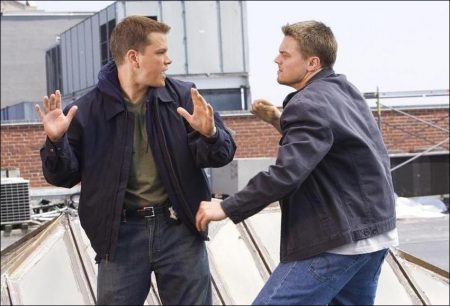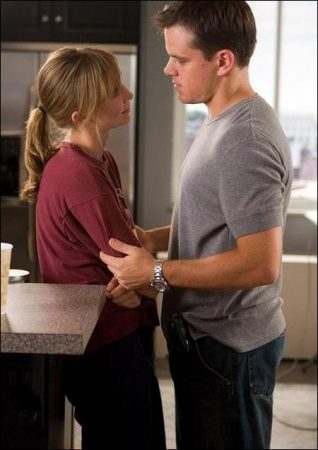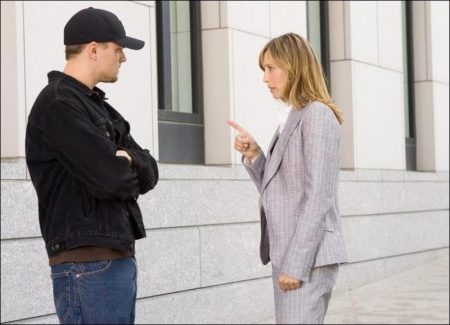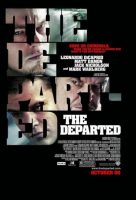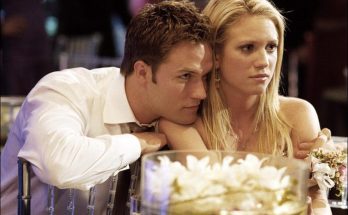Tagline: Cops or criminals. When you’re facing a loaded gun, what’s the difference?
The Departed movie storyline. In South Boston, the state police force is waging war on Irish-American organized crime. Young undercover cop Billy Costigan is assigned to infiltrate the mob syndicate run by gangland chief Frank Costello. While Billy quickly gains Costello’s confidence, Colin Sullivan, a hardened young criminal who has infiltrated the state police as an informer for the syndicate is rising to a position of power in the Special Investigation Unit.
Each man becomes deeply consumed by their double lives, gathering information about the plans and counter-plans of the operations they have penetrated. But when it becomes clear to both the mob and the police that there is a mole in their midst, Billy and Colin are suddenly in danger of being caught and exposed to the enemy – and each must race to uncover the identity of the other man in time to save themselves. But is either willing to turn on their friends and comrades they’ve made during their long stints undercover?
Based on the Chinese-linguage Hong Kong gangster film of the same name (“Wu jian dao”), “Infernal Affairs” will be reset in Boston amid Irish-American mobsters and the cops who are their nemeses. The film was written by William Monahan. “The Departed” is set in South Boston, where the state police force is waging war on organized crime.Young undercover cop Billy Costigan (Leonardo DiCaprio) is assigned to infiltrate the mob syndicate run by gangland chief Costello (Jack Nicholson).
Hong Kong to Boston
“The Departed,” the gritty crime drama from director Martin Scorsese, takes us into the lives of two cops: Colin Sullivan, smart and unabashedly ambitious, appears to be on the fast track in the Massachusetts State Police Department’s elite Special Investigations Unit, whose prime target is powerful Irish mob boss Frank Costello.
Billy Costigan, street-smart and tough, is purported to have a violent temper that costs him his badge and eventually lands him back on the rough streets of South Boston, where he is recruited into Costello’s ranks. But neither man is what he seems and, as they work at cross purposes, they are plunged into a dangerous game of cat and mouse in which the stakes could not be higher.
The story of “The Departed” is based on the 2002 crime thriller out of Hong Kong called “Infernal Affairs,” which achieved great success in Asia before coming to U.S. shores in 2004. An American version was soon in the works, with William Monahan writing the screenplay.
The screenwriter recalls, “I hadn’t seen ‘Infernal Affairs,’ and I didn’t want to watch it before adapting the story. I worked from a translation of the Chinese script. There was a great central story around which I could create new characters. I loved the duplicity of the characters in the Chinese film, but my adaptation, thematically, is all about the engine of tragedy that is started when people depart from what they really should be doing with their lives.”
“‘Infernal Affairs’ is a very good example of why I love the Hong Kong cinema, but ‘The Departed’ is not a remake of that film,” states Martin Scorsese. “It was inspired by ‘Infernal Affairs’ because of the nature of the story; however the world William Monahan created is very different from the Hong Kong film. When I received the script, it took me quite a while to read through it because I began visualizing the action and getting into the nature of the story and the characters. One of the things that hit me was that the depiction of the characters and their attitudes toward the world in which they live was so uncompromising. That’s what really got me interested in directing the movie.”
Producer Graham King notes, “You could say ‘The Departed’ takes Martin Scorsese back to his days of ‘GoodFellas’ and ‘Mean Streets,’ which is a genre he has been identified with in the past. But in this film, he’s taking that genre and turning it into something new and different and original. That’s what Marty does.”
“Working with Martin Scorsese was extraordinary,” Monahan says. “It was a privilege to see him put the film together in his mind as we were discussing the script. It’s like having years of film school packed into each and every day.”
Monahan relates that he set “The Departed” in a world with which he was very familiar. “The project came about at a time when I was thinking about Boston, where I came from, and about the people I had lost in my own life. So it allowed me to explore themes that were very personal to me.”
Thomas B. Duffy, a 30-year veteran of the Massachusetts State Police, who served as a technical consultant for the film, reveals that the screenwriter’s decision to center the film on the battle between the “Staties” and Boston’s Irish mob has its basis in reality. “Certainly in ‘Southie,’ the Irish mob dominated and controlled the city’s underworld, at least from the early 1970s until just a few years ago. They were the pinnacle of the criminal world there.”
Collaborating for the third time with Scorsese, actor Leonardo DiCaprio comments, “As much as it is a gangster movie, ‘The Departed’ is unlike anything Marty has ever done. It deals with a very different set of circumstances—not just that it involves the Irish underworld, but also the fact that it deals with the police force and the corruption there, as well. It is also set in a completely different environment, being Boston, not New York. Although, as we went on, we saw it more as a story of America and the corruption of certain systems in our country as a whole.”
It is a story, Scorsese says, of “how two young men are shaped by the forces in their lives: the institution of the police and a crime group headed by a figure named Frank Costello. Costello takes Colin as a young boy and makes him into a seeming pillar of the community so he can rise up in the hierarchy of the state police. But, in reality, he is Costello’s inside man. At the same time, Billy is the perfect material for the police to send undercover, because he comes from the working-class element of South Boston. He is put in the position to join Costello’s crew, but he has really been set up to rat on Costello. It’s like Billy and Colin are running on parallel tracks…but they will ultimately end up on a collision course.”
Cops or Criminals…
Leonardo DiCaprio stars as Billy Costigan, a promising cadet at the Massachusetts State Police Academy, who is selected for a dangerous undercover assignment before he has even had a chance to pin on a badge. The actor says that the role represented more than an opportunity to work again with Scorsese. “I read the script and immediately wanted to be a part of it. I just couldn’t put it down, and I said ‘yes’ without any deliberation or hesitation. I thought it was a really intense story with multifaceted and very compelling characters.”
Billy Costigan came up from the streets of Boston, and DiCaprio remarks that his character’s motivation to become a police officer is rooted in his desire to escape his upbringing. “Billy comes from an underworld background and has all the chips stacked against him in a lot of ways. I think he joins the police force because he has no other options, and he wants to do things differently than his family did. Ironically, he is asked to go undercover and pretend to be the very thing he was determined not to become. At the heart of it, I think Billy is ultimately trying to redeem himself and not just be a product of his environment, but he ends up deep in a situation that is extremely dangerous and deceitful. There are moments when he could so easily be caught—all the arrows are pointing in his direction as the ‘rat,’ and everything begins to cave in around him.”
Scorsese notes, “As an actor, I knew Leo would convey the conflict of a young man who has gotten himself into a bad situation and then wonders what the hell he is doing there. You can see it in his face; you can see it in his eyes. That’s one of the reasons I like working with Leo; he knows how to express emotional impact without saying a word. It just emanates from him. It is quite extraordinary to watch.”
Colin Sullivan is another member of the Massachusetts State Police Force with roots in South Boston who is also leading a double life, although Colin’s is the mirror opposite of Billy’s. A native of Boston himself, Matt Damon stars in the role of Colin, a young hotshot in the department, who has quickly risen to the rank of sergeant in the elite Special Investigations Unit while his Academy classmates are still in uniform. However, despite what he has led his superiors to believe, there is only one authority to whom Colin actually reports: mob boss Frank Costello.
“Matt brought a lot to the part of Colin,” states Scorsese. “I love that you can see his mind working as Colin is trying to figure his way out of his latest predicament and save himself, even as he gets himself in deeper and deeper over his head. In a way, Colin is an even more tragic character than Billy, because he truly believes he will get away with everything and that, by aligning himself with evil, he has created an inroad to redemption, so to speak, represented by the upper class society of Beacon Hill and the State House—that golden dome he keeps staring at. In the beginning of the picture, you see Costello teaching Colin a false set of values and, by a certain point in time, Colin has no values at all.”
Damon offers, “In Colin’s neighborhood, the character of Frank Costello is bigger than life. Everybody knows who he is and is terrified of him. The first time Colin comes in contact with him, Colin is about 12 years old, and that kind of interaction would be incredibly meaningful to a kid from that neighborhood. Costello is even more powerful than a father figure in Colin’s mind, and you see the relationship develop from the very beginning.
Costello can afford to bide his time because, as Damon says, “Inevitably, boys grow into men and Costello knows he will be able to use the loyalty Colin has for him.
He gets Colin to join the state police to act as an informant for him. So while one guy is an undercover cop in the mob, the other is a cop undercover for the mob.”
“Our characters are two sides of the same coin, even coming from the same neighborhood,” DiCaprio agrees. “Colin chose one path and Billy chose another, but their lives are intertwined… linked in ways they could never understand. It becomes this really intriguing chess game of information and disinformation.”
The most obvious link between Billy and Colin is their unknowingly shared connection to Frank Costello, who is portrayed by the legendary Jack Nicholson. “The Departed” marks the first collaboration between Nicholson and Scorsese, although, the director says, “Jack and I have known each other for 30 years. For some reason, we had never quite connected on a movie, so I thought it would be interesting to see if he had any desire to take on the role of Costello. It may have taken a long time, but it was worth the wait because we had quite a time together on this picture.”
Graham King recalls, “When Marty first mentioned Jack Nicholson for the role, I thought we were dreaming, but it became a reality. Jack took the character of Costello to another level, as only he could do. There are so many of what I call ‘Jack moments’ in the film, which are just terrific.”
“Jack really made the character his own,” Scorsese attests. “Costello has had everything in life, so he doesn’t give a damn about anything anymore. And why should he? He has all the power. But now, he starts taking too many risks, like putting himself on the front lines of drug deals. He knows he doesn’t have to do that; it’s just for the thrill of it at this point in his life. Costello has gotten too old, and he knows, ultimately, he is probably on his way out. It was interesting to watch Jack portray Costello starting to unravel.”
“Jack Nicholson is a force of nature,” DiCaprio adds. “He can be very unpredictable when he’s on camera, so you have to learn to roll with the punches. I mean there were moments during filming that I didn’t know what was going to happen next; I was never sure which side of Costello he was going to be playing on any particular day. That can be very exciting for an actor to play against, because it really keeps you on your toes.
There are only two people in the Massachusetts State Police who know the newest addition to Costello’s crew is an undercover cop: Captain Queenan and Sergeant Dignam.
Mark Wahlberg stars as Sergeant Dignam, a hard-nosed detective who, the actor acknowledges, “is a mean, miserable guy, and he is not going to pretend to be anything else. He is very in-your-face, but, at the same time, he’s pretty on the level.”
“Mark Wahlberg is just remarkable as Dignam,” Scorsese says. “He comes from the Boston area, so he knows that world fairly well and really knew this character. Dignam is who he is; nothing is going to change his attitude towards anyone or anything. He’s seen it all and heard it all, and there is nothing you can put past him. You can try, but he’ll always have an answer for you, and it will most likely be only two words…I think you know what they are,” Scorsese laughs.
Raised in the working-class neighborhood of Dorchester, Wahlberg found it natural to revert to his native Boston accent, although, he jokes, “I don’t think Marty knew what I was saying half the time. He would say, ‘We might have to use subtitles at some point.’”
Describing his hometown as “a pretty rough place to grow up,” Wahlberg asserts, “There is only one Boston. It has a reputation as this amazing school town, but there are also those neighborhoods where you are either going to become a crook or a cop or a construction worker. There’s not too much in-between. My being raised there has an effect on everything I do, whether it’s obvious or not. I didn’t have to do much homework for this movie—I’ve known a lot of these guys—the only difference is I was playing one of the cops who used to arrest me all the time.”
Countering Dignam’s abrasive style is the level-headed Captain Queenan, played by Martin Sheen. The actor reveals that he took the part even before reading the script. “What made me say ‘yes’ almost instantly was the opportunity to work with Martin Scorsese. I had never worked with him before, but he has always been one of my favorite directors. With that in mind, how could I make a mistake? Then, of course, I read the script, and I thought it was a great story of divided loyalties and betrayal in the context of law enforcement and criminality. Sometimes they mix and overlap, and you’re hard-pressed to tell the difference.”
Sheen adds that, while Queenan is not unsympathetic to Billy’s growing desperation, he cannot afford to let that interfere with the objective. “He understands that Billy’s identity has been swallowed up by going undercover. Except for Queenan and Dignam, the cops know Billy only as a gangster and, if Costello discovers he’s a cop, he’s a goner. It’s a precarious position because both sides could take him out at any time.”
Billy’s real identity isn’t even known to the head of the Special Investigations Unit, Captain Ellerby, portrayed by Alec Baldwin. “Ellerby is obsessed with bringing down Costello and smashing his crime ring,” Baldwin states. “He views Costello as being violent and depraved, so Ellerby is willing to bend the rules to suit his purposes. But he is a good cop, nonetheless.”
Although Frank Costello has more than earned his violent reputation, he has rarely done his own dirty work. Instead, he relies on a gang of brutal henchmen, none more so than the one who goes by the name Mr. French. British actor Ray Winstone, who plays the role of Costello’s top man, describes his character as “one of those guys you get nothing from—he doesn’t trust anyone, doesn’t like anyone…probably doesn’t like himself. To him, everyone is a rat. As an actor, I’m always trying to find the emotion in a character, the weaknesses as well as the strengths. It started to dawn on me early on that French is without emotion. Nothing rattles him, and nothing frightens him, but if you get in his way, he’ll kill you without a second thought. His only loyalty is to Costello.”
The one main character in “The Departed” who is neither a cop nor a criminal is also the only woman. Vera Farmiga plays Madolyn, a psychiatrist who specializes in dealing with troubled people on both sides of the law. In a twist of fate, she becomes another unwitting link between Colin, the man she is seeing romantically, and Billy, the man she starts out seeing professionally. Farmiga offers, “To Madolyn, Colin appears to be a man who has it all together. He represents security and commitment for her, while Billy is more intimacy and passion. He seems to be a bit of a derelict, but they are drawn to each other.
DiCaprio notes, “Madolyn is the only emotional connection Billy has. She is the one person Billy can confide in, although in a very limited way because he can’t reveal anything about himself or what he’s doing. As his counselor, she tries to help him initially, but then a stronger bond develops between them.”
“What I liked about the character of Madolyn is that you have this psychiatrist who is intuitive, but who is not following her own instincts. I loved that contradiction,” says Farmiga.
Rounding out the main cast of “The Departed” are: Anthony Anderson and James Badge Dale as state troopers Brown and Barrigan, who eventually become part of the Special Investigations Unit; and David O’Hara and Mark Rolston as Fitzy and Delahunt, two of Costello’s henchmen.
“One of the best parts of producing a Scorsese film is the casting,” Graham King remarks. “Marty has a way of picking the most amazing actors for each role, and this film was no exception.
Matt Damon offers, “Working with Martin Scorsese is about as good as it gets for an actor. I learned so much just watching him shoot this movie. He has a great eye for behavior and for discerning what’s real and what’s not. So many of the brilliant moments for which he’s been responsible have been those that delve into character. As actors, we love to explore those moments; that is one of the reasons we all want to do his movies.”
“How does one make a motion picture?” Scorsese proposes. “You make it with different instruments, so to speak. The story, the language, the milieu, the people portraying the parts—these are all instruments. Of all these extraordinary elements, the one I tend to rely on most often to tell the story is the cast. To have the actors we had in this film all together was remarkable.”
Act Accordingly…
Prior to the start of principal photography, a number of cast members began training for their roles, most with the help of technical consultant Tom Duffy. Recently retired, Duffy had served three decades with the Massachusetts State Police, a significant portion of which was spent in the Special Investigations Unit, targeting organized crime, including the Irish mob. His background and experience made him an invaluable resource for the cast, as well as the filmmakers.
Executive producer G. Mac Brown says, “When you start looking for a technical consultant, you don’t always know where or if you’re going to find the right person. We had learned about Tom and knew he was a retired state trooper, so we got his number and just made a cold call. He ended up coming through with flying colors.”
Working on his first feature film, Duffy was duly impressed by Scorsese’s commitment to accuracy, from the police terminology to the attire. “I was somewhat overwhelmed by his attention to detail,” Duffy admits. “We went through a painstaking process to make sure everything was as authentic as possible, not just about the rudiments of police work, but in trying to get into the minds of the officers. Keeping in perspective that it’s a piece of entertainment, I think it’s very realistic.”
The director was not the only one who benefited from Duffy’s expertise. Matt Damon confirms, “I’m from Boston, so there are cultural aspects of the city that are second nature to me, but that didn’t address the subculture of the state police. To have a person like Duffy, with his breadth of actual experience, take me under his wing—it was everything to me. Duffy gave me information and showed me around and connected me with other state troopers. I was able to spend days with them, picking their brains and watching them in action. I even went on a ride-along and, at one point, went in on a drug bust with these guys. That’s the kind of experience you can’t approximate. It’s really the fun part of the job,” he smiles.
Brown remembers that he wasn’t exactly smiling when he got the phone call about Damon’s brush with Boston’s criminal element…after the fact. “Matt calls and he’s all excited because he’s gone out on this ride-along. And I’m thinking, ‘Thanks a lot, Duffy,’” Brown kids. “I mean, that’s just great for Matt, but, as a producer, you worry about your star going out on a real raid with real police and real guns at a real crime scene. Obviously, it all worked out okay.”
For Damon, the time spent with the real troopers had an impact on his portrayal of Colin that went beyond the practical applications. “It was really humbling to see the troopers’ commitment to what they do, often at tremendous risk. As I was thinking about Colin, I realized that, at some level, he must have a deep, deep disdain, not just for the law, but for police officers themselves. To be that close to that kind of selfless sacrifice every day and then to want to undo it says a lot about who he is. There were so many things I was able to bring to my performance that I would not have known without that time with the experts, so what Duffy did for me was incalculable,” Damon states.
Duffy also advised Martin Sheen and Alec Baldwin on the correct demeanor for ranking members of the state police. In fact, Sheen notes, “I based my character a lot on Tom Duffy. Whenever I shot a scene, I would try to think how Tom would do it…and he was right there to make sure I did it right.”
Although DiCaprio’s Billy Costigan spends most of the movie acting more like a criminal than a cop, the actor was nevertheless able to profit from Duffy’s years of undercover experience. “Working undercover requires a certain state of mind,” Duffy says. “Leo and I talked a lot about the toll it can take over time.”
“The whole idea of what it is to be a cop in that circumstance, and the mindset I had to get into, would not have been as authentic without him,” DiCaprio attests. “He was a tremendous help throughout the entire shoot.”
In preparing to play a native Bostonian, DiCaprio also knew the importance of immersing himself in the local culture. “I definitely felt I needed to go to Boston and walk around and get a feeling for the people,” he says. “Everyone there was extremely supportive and tried to help me as much as they could. There was someone I hung out with, who took me down to the old neighborhoods and also helped me with the accent. It really helped me get into the character.”
“Leo was at a real disadvantage coming into this movie,” Damon allows. “I mean, he had to do a lot of preparation work that Mark Wahlberg and I didn’t have to do because we both grew up in Boston. There is a very particular attitude and culture there, and Leo did a great job capturing that. It was truly impressive.”
The Big Apple Meets Beantown
While “The Departed” is set entirely in Boston, principal photography on the film was accomplished in and around the cities of both Boston and New York. Production designer Kristi Zea, who had earlier collaborated with Scorsese on “GoodFellas,” observes, “‘The Departed’ does have some of the same elements as ‘GoodFellas,’ but, of course, this film takes place in Boston. Because we had worked together before, Marty could refer to things we had done back then and say, ‘Remember that thing we did on ‘GoodFellas?’ I want something like that…only, what’s the Boston version? I’d scratch my head and say, ‘Well, I’m not sure, Marty, but we’ll find out,’” she laughs. “It was great to do another film with him.”
Almost all of the film’s exterior scenes were shot in Boston at such sites as Boston Common, Boston Harbor, Chinatown, and, of course, South Boston, known to the locals as “Southie.” Traveling outside of the city, the company also filmed in the neighboring towns of Braintree, Quincy and Mark Wahlberg’s hometown, Dorchester. In New York, the company stayed primarily outside of Manhattan proper, instead having areas of Brooklyn double as Boston, mostly for interior scenes.
“The fact that we shot this movie in two different cities is not unusual,” Zea relates, “but in this case, the differences between New York and Boston are pretty evident as you drive around. Outside of downtown Boston, most of the structures are quite low and there is lots of sky, whereas most of the New York sky is filled with high-rises. It’s very difficult to do much in New York that looks like Boston from an exterior point of view, which is why we stayed mainly in Brooklyn. In Boston, there is also a specific style of New England architecture that doesn’t exist in New York, like the three-story wooden houses with front or back porches on each floor. That is something of a signature Boston look that we made sure to have in our film. Another element that was fascinating to me is the “brutalist” mode of architecture, which is the cement look that certain buildings were designed with in Boston, including City Hall and the Hurley Building.
Juxtaposed with the city’s historical landmarks, the imposing, cement-gray Hurley Building, in the heart of Boston’s Government Square, was selected to serve as the exterior for the utilitarian headquarters of the Massachusetts State Police. Zea and her team then created the interiors of the headquarters on a cavernous soundstage in the Williamsburg section of Brooklyn, New York. “We decided to carry over the gray and brown palette of the existing structure, which really worked well for those sets,” she says. Director of photography Michael Ballhaus took a similar approach in lighting the police headquarters. He offers, “Police stations are normally lit with fluorescents, but I didn’t want to do that because fluorescents create a wash of light, which has no tension. I decided to use direct light and shadows to add variety and texture to the atmosphere.”
Ballhaus, who had previously teamed with Scorsese on six films, states, “I don’t think Marty and I have ever talked so much about lighting. The whole movie was somewhat influenced by film noir. We lit it almost like a black-and-white film, especially in the police station, which didn’t have much color. But even if you don’t have a lot of color, color is still something you can use in a dramatic way.”
Costume designer Sandy Powell utilized color to set Jack Nicholson’s character apart from the rest. She comments, “Basically, everybody else is in ordinary street clothes in neutral tones of black, brown, gray and beige. That’s pretty much it. Originally, we were just going to make Frank Costello blend in, but after meeting Jack, it was obvious he wanted to take the look a little more to the extreme in terms of color and design. Costello is a guy who has so much power, he can wear whatever he wants and no one would dare question it. So we definitely had more leeway with his character’s wardrobe.”
Within the almost colorless settings, the occasional injection of the color red was both dramatic and deliberate. Zea confirms, “We intentionally made the costumes and the sets fairly monochromatic, but Marty, Michael Ballhaus and I collectively made the decision that whenever we used red, there was a reason for using red. It’s intended as a subliminal message that something of a dangerous nature is about to happen, with blood being the obvious correlation.”
The letter X was also used symbolically throughout the movie, at the behest of Scorsese, who meant it as an homage to the 1932 movie “Scarface,” directed by Howard Hawks and produced by Howard Hughes, in which the X has a special significance. “Marty asked us to utilize the letter X wherever we could,” Zea reveals, “so you can see X’s on windows, on walls, on floors…”
“The X is a sign of death, so Marty wanted us to include them—sometimes subtly and sometimes not so subtly,” adds Ballhaus, who even used lighting to project X’s into certain scenes.
The concept of death harkens back to the title. Monahan explains, “In the Catholic Church, we would refer to the dead as ‘the faithful departed.’ I started playing around with that idea and the fact that, ironically, this movie is about faithlessness—to others, of course, but most fatally to the characters’ own best interests, so I thought the title fit.”
Scorsese concludes, “William Monahan is an Irish American from Boston, so he placed his characters in that milieu. Nevertheless, the movie is about people in a situation that, in a sense, could be found in any city around the world. It is a story of trust and betrayal and deception and loyalty, which could be told anywhere.”
The Departed (2006)
Directed by: Martin Scorsese
Starring: Leonardo DiCaprio, Matt Damon, Jack Nicholson, Mark Wahlberg, Martin Sheen, Ray Winstone, Vera Farmiga, Anthony Anderson, Alec Baldwin, Kevin Corrigan, Kristen Dalton
Screenplay by: William Monahan
Production Design by: Kristi Zea
Cinematography by: Michael Ballhaus
Film Editing by: Thelma Schoonmaker
Costume Design by: Sandy Powell
Set Decoration by: Leslie E. Rollins
Art Direction by: Teresa Carriker-Thayer
Music by: Howard Shore
MPAA Rating: R for strong brutal violence, pervasive language, strong sexual content, drug material.
Distributed by: Warner Bros. Pictures
Release Date: October 6, 2006
Views: 66
